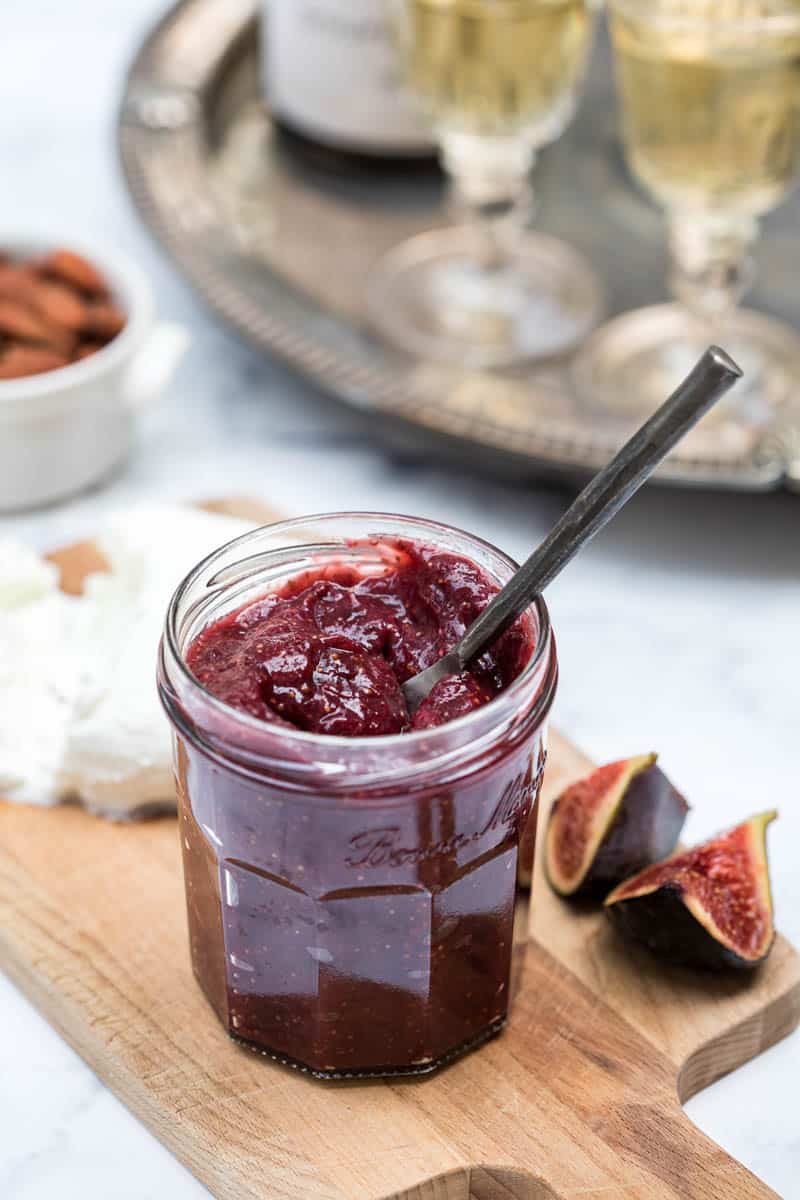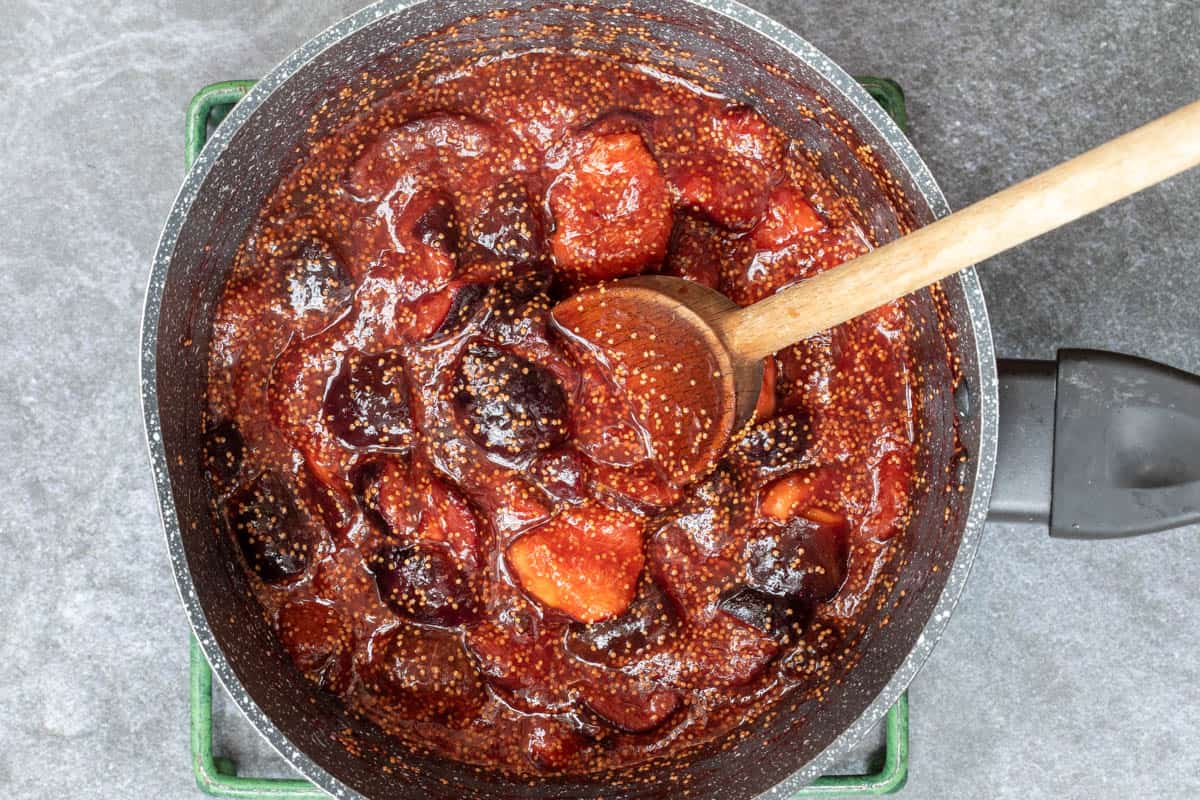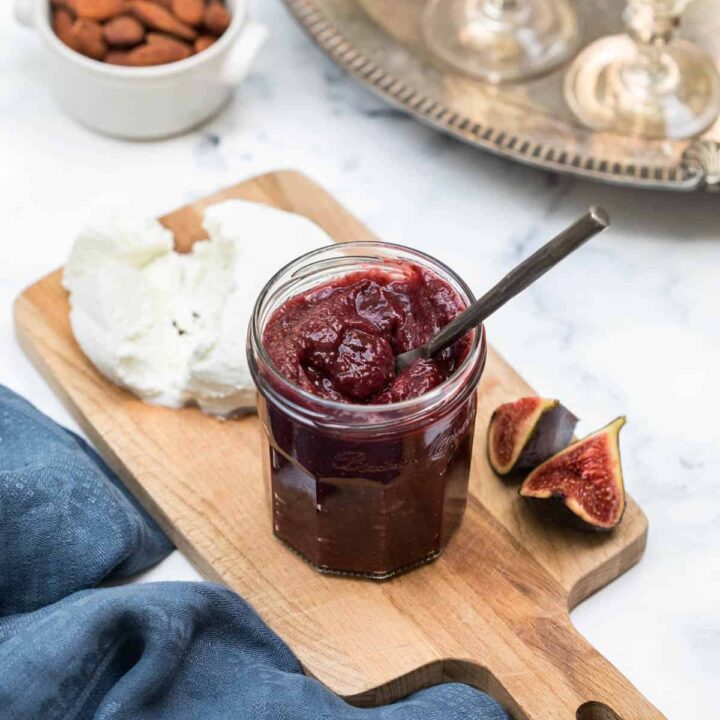This fig spread is sweet and jammy, perfect on toast or with a cheese plate. Just simmer ripe fresh figs with honey and balsamic vinegar, then blend. Easy and delicious!

It’s not an exaggeration to say that I’ve been slightly obsessed with fresh figs this fall. Plump and sweet, with a deep red-purple color that reminds me of a blackberry pâte de fruit—fig perfection!
Of course they are fantastic on their own or in salads, but did you know it is super easy to make them into fig spread? Just 30 minutes to make a batch that you can eat or freeze to enjoy well after figs have left the markets.
And stay with me, because this fig spread may just be your secret weeknight weapon.
Why Make This Recipe
- Quick and easy to make. Don’t let the idea of making jam intimidate you (ha ha, that’s why I’m calling this “fig spread”). You just simmer the ingredients together, then blend.
- No canning necessary! Once you’ve made your fig spread, you just store in empty jam jars or another airtight container and keep in the refrigerator or freezer. Since you’re not canning it to store on a shelf, you don’t need to worry about having the right amount of sugar in the jam or whether it passes the wrinkle test.
- Delicious in so many forms. Fig spread is not just for toast! Once you have a jar in your refrigerator, you’ll be surprised how many uses you can find for it for breakfast, lunch, dinner, and dessert. See below for ideas.
🥗 Ingredients

- Fresh Figs: Figs can really vary in sweetness depending on how ripe they are. This recipe works best with very ripe, sweet figs. They should feel heavy for their size and have some give to them—perfectly ripe figs are delicate enough that you need to handle them carefully so they don’t tear. If your figs aren’t quite ripe, you may need to add additional sugar or honey to this recipe to make the fig spread sweet enough.
- Balsamic Vinegar: Try replacing with red wine vinegar or even lemon juice if you don’t have balsamic vinegar. You can go without it as well, but I like the balance it brings to a sweet dish.
- Honey: You can replace this with regular sugar if you like, or add some maple syrup instead. For a vegan version of this recipe, replace the honey with another type of sweetener, and see my note in the FAQs about vegan varieties of figs!
🥣 Instructions
Stem figs, then chop.

Add chopped figs, sugar, water, honey, balsamic vinegar, and vanilla extract to a medium-large saucepan.

Bring to a boil over medium-high heat, then turn down the heat to medium and simmer for 15-20 minutes. Stir frequently. Add more liquid if the mixture appears dry or starts to scorch on the bottom.
The figs will begin to break down, and the liquid in the pan will begin to thicken, with larger bubbles coming to the surface more slowly.

Turn off the heat and let cool for 15 minutes. Then blend with an immersion blender or in a food processor, making it as smooth or chunky as you like. Refrigerate in jars for up to a week.

🧐 Recipe FAQs
Yes, you can freeze fig spread for up to 3 months. Defrost in the refrigerator for 24 hours before serving, then use within a week of defrosting.
Figs are in season generally from August through early October. Fig trees thrive in Middle Eastern and Mediterranean climates, as well in California, where fig trees were introduced in the late 1800s. 90% of global fig production comes from the Mediterranean region.
Definitely. Figs are high in fiber, low in calories, and contain calcium, potassium, magnesium, manganese, iron, and vitamin K. Dried figs provide even more fiber and higher percentages of recommended daily nutritional value of vitamins and minerals. As a result, dried figs in particular are great for constipation.
Kind of? Figs are fascinating because rather than a true fruit, they are really inverted flowers pollinated by the fig wasp. Female fig wasps crawl into unripe figs to lay eggs. They pollinate some of the female flowers inside the figs, then die.
The female’s eggs hatch into baby wasps who are able to burrow out and fly away with the fig pollen they carry, thus repeating the cycle. The fig with the dead female wasp digests it completely as it (the fig) ripens. So by the time you eat a ripe fig, there is no evidence of the wasp that pollinated it.
That said, vegans do not eat figs because of this concern. Though there is hope for vegans, as some varieties of figs are called “parthenocarpic”, which do not require pollination and so do not rely on fig wasps to grow fruit. This is the same type of innovation that brought you seedless watermelons!
👩🍳 Expert Tips
The key to this dish is simmering the jam gently and using the right amount of liquid. Too much liquid, and you’ll end up with a watery spread. Too little liquid, or too high heat, and you’ll scorch the jam and make it taste bitter.
Unfortunately, there’s no way to give an exact amount of liquid in the recipe directions—it depends quite a bit on how ripe your figs are. So just try to make sure you have enough liquid so that the mixture does not look dry, or start to sizzle like it is scorching the bottom of the pan.
And add the liquid a little bit at a time, so that you don’t accidentally overwhelm the figs. If it turns out you have added too much liquid, simmer it for longer to boil out some of the extra water.
Make the spread as chunky as you like. I prefer a smoother texture, so I like to really blend well with my immersion blender. But if chunky is your style, you can just blend lightly with an immersion blender, or put half of the spread into your blender or food processor to blend and then stir in with the unblended spread in your pan.

What Can I Do with Honey Balsamic Fig Spread?
You can level up almost any meal with this fig spread. Swirl some in your yogurt or spread on toast for breakfast or over vanilla ice cream for dessert. Serve on a cheese board with a mild goat cheese or Spanish cheese like manchego. Use in this fantastically delicious Baked Brie with Jam recipe.
And for dinner, you ask? How about using it as a glaze for chicken or duck? Or make it a “fancy grilled cheese” night (which at my house comes almost every week), with a layer of fig spread in your grilled cheese. Add some caramelized onions if you want to gild the lily.
Finally, how about a tartine with fig spread, goat cheese, and thinly sliced prosciutto? Once you’ve got the jam, that one’s on the table in 5 minutes flat. Or, try an upscale PB&J by pairing this with homemade Pecan Cashew Nut Butter.
And dessert? Add to cheesecake batter to delicious effect. Or use as a filling for sweet crepes, perhaps mixed with cream cheese. And don't forget to try it as a filling for these delicious Linzer Cookies.

Other Fall Recipes
If you enjoyed this Honey Balsamic Fig Spread recipe, you might want to check out some of my other delicious recipes that take advantage of early fall produce.
- Fig Salad with Blue Cheese
- Red Radish Crostini with Lemon Ricotta
- Carrot Ginger Soup with Creme Fraiche
- Pear Gorgonzola Salad with Glazed Walnuts
- Sweet Potato Gratin with Blue Cheese
- Braised Leeks with Crispy Bacon
- Turmeric Latte
- Curry Coconut Butternut Squash Soup
If you try this fig spread recipe, I would love to hear from you! Leave a comment below—I read them all, and your feedback is invaluable to me.
And please follow along on Instagram, Pinterest, and Facebook or subscribe to my newsletter. I'd love to inspire you with more delicious, healthy, and seasonal recipes!
Want to Save This Recipe?
Enter your email & I'll send it to your inbox. Plus, get great new recipes from me every week!
By submitting this form, you consent to receive emails from Vanilla Bean Cuisine.
📖 Recipe

Honey Balsamic Fig Spread
This fig spread is sweet and jammy, perfect on toast or on a cheese plate. Ripe fresh figs simmered with honey and balsamic vinegar, then blended into a spread.
Ingredients
- 1 lb. fresh figs (about 11 figs)
- 2 T. sugar
- ¼ c. water
- 1 T. honey
- 1 T. balsamic vinegar
- 1 t. vanilla extract
Instructions
- Stem figs, then chop.
- Add chopped figs, sugar, water, honey, balsamic vinegar, and vanilla extract to a medium-large saucepan.
- Bring to a boil over medium-high heat, then turn down the heat to medium and simmer for 15-20 minutes. Stir frequently. Add more liquid if the mixture appears dry or starts to scorch on the bottom. The figs will begin to break down, and the liquid in the pan will begin to thicken, with larger bubbles coming to the surface more slowly.
- Turn off the heat and let cool for 15 minutes.
- Then blend with an immersion blender or in a food processor, making it as smooth or chunky as you like.
- Refrigerate in jars or other airtight containers.
Notes
- This fig spread must be refrigerated since we did not seal the jars by water-bath or pressure canning. Use within a week. If you want to store the fig spread for longer, you can freeze it for up to 3 months. Defrost in the refrigerator for 24 hours before serving, then use within a week of defrosting.
- The key to this dish is simmering the jam gently and using the right amount of liquid. Too much liquid, and you’ll end up with a watery spread. Too little liquid, or too high heat, and you’ll scorch the jam and make it taste bitter. Unfortunately, there’s no way to give an exact amount of liquid in the recipe directions—it depends quite a bit on how ripe your figs are. So just try to make sure you have enough liquid so that the mixture does not look dry, or start to sizzle like it is scorching the bottom of the pan. And add the liquid a little bit at a time, so that you don’t accidentally overwhelm the figs. If it turns out you have added too much liquid, simmer it for longer to boil out some of the extra water.
Nutrition Information:
Yield: 8 Serving Size: 1Amount Per Serving: Calories: 65Total Fat: 0gSaturated Fat: 0gTrans Fat: 0gUnsaturated Fat: 0gCholesterol: 0mgSodium: 2mgCarbohydrates: 17gFiber: 2gSugar: 15gProtein: 0g
Nutrition information is provided as a general reference for users courtesy of the online nutrition calculator Nutritionix.
Instagram Users: Now that you've made this recipe, tag me @vanillabeancuisine or #vanillabeancuisine because I'd love to see your results!



Susan Schmidt says
I would love to make this in quantities for gift giving! It's so easy. What if I can't find enough figs? Can I use pears with the same recipe?
Molly Pisula says
Hmm, I'm not sure. You could definitely try it. I would think you might have to adjust the amount of liquid and the amount of sugar--the pears might have a different amount of liquid and sugar in them vs. figs. But all of those things can be adjusted! Also, you might want to peel the pears to make a smoother jam.
Kim says
Hi! I was wondering if this recipe could be water bath canned for longer storage?
Molly Pisula says
I would think it could be, but I am definitely not a canning expert. You could also freeze it for a few months. (I tend to eat mine too quickly to need long term storage! 😄 )
Kristina Kopacz says
Can I use previously frozen figs for this recipe?
Chef Molly says
Sure, that shouldn't be a problem. I'd defrost them first. Just know that they will probably be more liquid-y than fresh figs, but this recipe is very forgiving. You may just need to cook them for longer to get the consistency you want for the spread.
Heidi | The Frugal Girls says
I really like how you have given this fig spread a fun Mediterranean flair... the flavors are so totally scrumptious!
Chef Molly says
Thanks Heidi! I love these flavors together for sure.